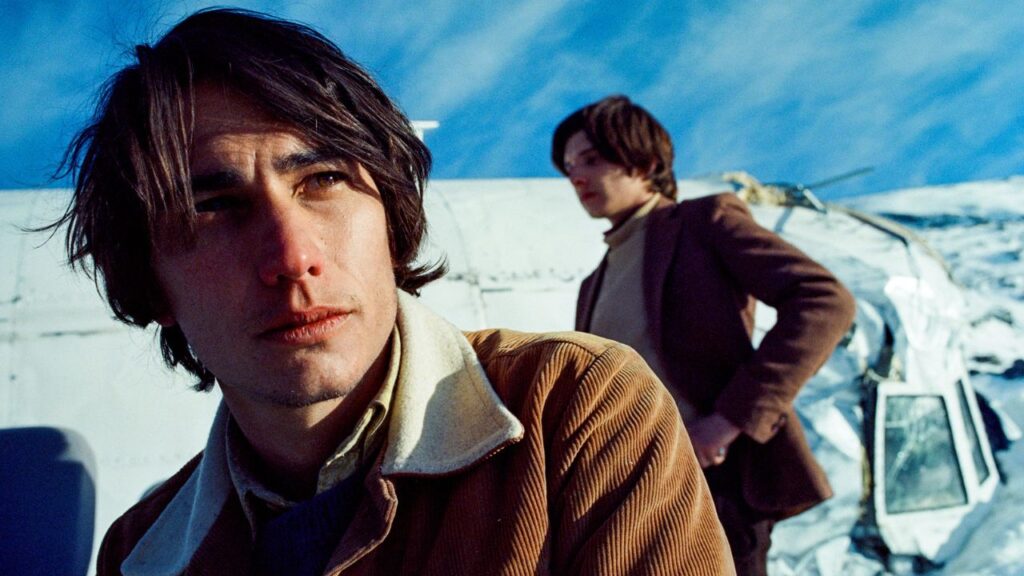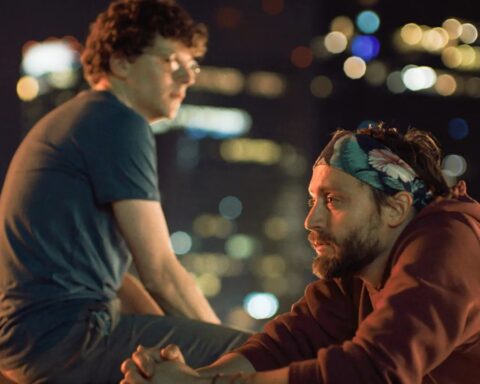In 1972, Uruguayan Air Force Flight 571 was carrying a team of bright young rugby players from the Old Christians Club rugby union team when it crashed in the Andes. The survivors endured 72 days of punishing cold and starvation. To survive, they resorted to cannibalising the dead. This sensational tragedy captured people’s imaginations worldwide. Stephen King even referenced it in The Shining.
Most people familiar with Flight 571 probably know it from Frank Marshall’s movie Alive (1993). Thirty years later, the Old Christians rugby team’s survival story is brought to prominence again in searing yet tender detail by J.A. Bayona. The Spanish director’s Society of the Snow being, arguably, the most faithful depiction of this disaster.
The Scary and the Sublime

First of all, credit to Bayona for putting together some of the most harrowing plane crash scenes I’ve ever seen on screen. The film unflinchingly displays the full horror of the airplane ripping apart and the passengers hurtling forward before being crushed and speared by their very seats. The scenes last only seconds, but the brutal force of it is a disturbing reminder of how fragile the human body is.
Even after the spectacular crash, Bayona successfully sustains a sense of dread and fear. The film’s cinematography is worthy of a nature documentary, with sweeping wide shots of the Andes in all their glory. In contrast, the plane’s survivors shrink to nothingness against this scale. For all man’s pretensions, it’s truly terrifying how puny he looks against the vastness and indifference of mother nature.
The beauty of the Andes is also transfigured into a constant threat thanks to some ominous background music. Watching the sprawling shots of the mountain range and the endless ice fields, I can finally appreciate what the Romantic poets meant by nature as sublime. I too felt the terror that was induced when facing nature’s sheer wildness and mercilessness.
Faithful Communions

Naturally, body horror features heavily in Society of the Snow, but it’s not necessarily the cannibalism that inspires the greatest horror. Yet again, that’s the one aspect that everyone’s already primed for. It is instead the small, quiet moments that induce genuine fear for the survivors. One memorably disturbing scene is when a survivor relieves himself, and the pristine snow is splattered black and not yellow. It’s a gruesome visual, and a shocking reminder that their bodies are consuming themselves.
There’s no ignoring that the story of Flight 571 is so captivating because of the chilling choices the survivors were forced to make, especially the decision to consume their dead in order to survive. A lesser filmmaker would’ve succumbed to the irresistible opportunity to sensationalise that act of cannibalism. But here, Bayona employs a respectful restraint as he explores the shame, self-revulsion, moral conflicts, and ethical dilemmas the survivors experienced.
The film smartly parallels the act of consuming human flesh with the Holy Communion. An early scene has the rugby team attending church and listening to a sermon on eating the body of Christ. Later, on the mountain, the boys, all Roman Catholics, willingly consent to sacrifice their bodies after death. The film’s narrator, Numa, movingly says that the greatest love is giving one’s life for one’s friends.
Friendships Forged in Fire and Ice

For all its bleakness, Society of the Snow is ultimately a film about friendship. This is, after all, a group of young teammates with a powerful bond. It is full of college humour as the boys laugh, crack dirty jokes, and rib each other about girls. The male camaraderie and their strength of friendship keep the group sane through the crushing hopelessness of their situation.
The film is bookended by two scenes of the friends showering together. Before the crash, the team shower in their locker room. There’s boisterous laughter, roughhousing, and male bodies in peak physical form. After they return to civilisation, the boys bathe in a hospital. Outside their thick jackets, their bodies are shockingly skeletal. There’s no more laughter, only the shell-shocked silence of men weighed down with sorrow and survivor guilt.
Both the plane’s survivors and the dead are honoured throughout the film. It was a nice touch that some of the actual survivors made cameos. Poignantly, one of the survivors who lost his mother and sister in the crash plays an older man at the airport who holds a door open for them to pass. Another plays his own father, embracing his son when he returns home.
Survival movies based on true events are tricky to get right. Society of the Snow successfully captures the intensity of the experience without resorting to brusque sensationalism. I think it’s safe to say that for the victims, the survivors, and their families, this movie is a tribute that honours this inspiring group of young men and their outstanding courage and friendship.









Follow Us